From Benedict’s Peace to Francis’s War looks at the new suppression of liturgical tradition from many perspectives
By Christina Deardurff
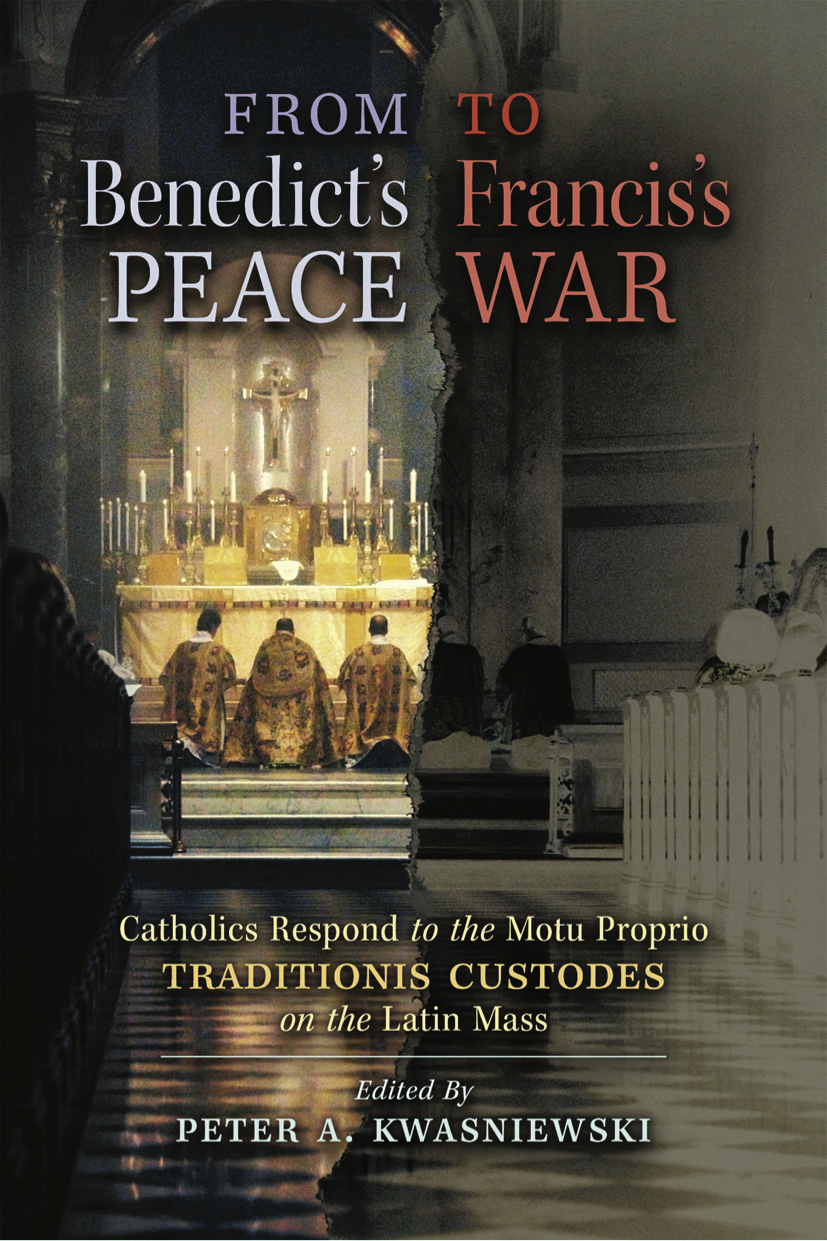
Peter Kwasniewski’s new book From Benedict’s Peace to Francis’s War. The book collected reactions to Pope Francis’s July 16, 2021 motu proprio Traditionis Custodes
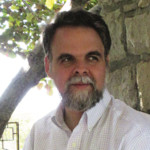 Author, educator, musician and liturgy scholar Peter Kwasniewski, an American, is not one to pull punches. Nor does From Benedict’s Peace to Francis’s War, his new book of collected reactions to Pope Francis’s 2021 motu proprio Traditionis Custodes. The book is an anthology of 70 essays written by 47 authors from quite diverse backgrounds, nations and callings — even an atheist – within a two-month window following the promulgation of the papal document in July 2021.
Author, educator, musician and liturgy scholar Peter Kwasniewski, an American, is not one to pull punches. Nor does From Benedict’s Peace to Francis’s War, his new book of collected reactions to Pope Francis’s 2021 motu proprio Traditionis Custodes. The book is an anthology of 70 essays written by 47 authors from quite diverse backgrounds, nations and callings — even an atheist – within a two-month window following the promulgation of the papal document in July 2021.
Dr. Kwasniewski calls it the result of “a worldwide passionate and articulate response” to Traditionis Custodes, which suppresses the use of the Traditional Latin Mass (“TLM”) — what Pope Benedict XVI had previously designated as the “Extraordinary Form” of the Mass in his own 2007 motu proprio Summorum Pontificum. In that document, Benedict liberalized the regulation of the TLM and, as it were, welcomed it back into the fabric of the Church’s liturgical life in a way that it had not enjoyed since its veritable whole-cloth replacement with the Novus Ordo (what Benedict called the “Ordinary Form”) in 1966. Francis’ motu proprio reverses all that. Inside the Vatican spoke with Kwasniewski about his book, published by Angelico Press, and what might be coming next on the Church’s liturgical horizon.
“The Mask Has Fallen”
An interview with Peter Kwasniewski, editor of From Benedict’s Peace to Francis’s War
Inside the Vatican: Tell us what this book is all about, and how the idea came to you.
Dr. Peter Kwasniewski: The motu proprio Traditionis Custodes and its accompanying letter prompted a worldwide flood of articulate and passionate responses, showing that the question of the Church’s relationship to her tradition—her duty to her own heritage and to the faithful who are sustained by it—is of vital importance for a broad segment of the faithful, even those who are not self-professed “trads.”
As I scrambled to keep up with the reactions, the conviction grew in me that the best essays, articles, interviews, lectures, etc. should be gathered into a single volume for convenience and “for the record.” Already early in September Angelico Press approved the concept and I got down to work, selecting, collating, editing, annotating, and, of course, contacting authors and publishers for permission. It was what I like to call a “grad school project”: I was working on it night and day, so that it could be available as soon as possible.
What will the reader find in the book?
Kwasniewski: We set basically a two-month window: materials written in the period of two months after July 16, 2021. Most of the content was published already at dozens of different websites, but there are several substantial pieces, especially by Dr. Joseph Shaw, that appear in print for the first time (having been given as talks), a number of translations that also appear only in this anthology, and finally a number of fresh translations of articles that had been poorly served in their initial appearances.
The final result was rather ambitious: 70 entries by 47 authors, including five cardinals (Brandmüller, Burke, Müller, Sarah, and Zen), three archbishops (Aguer, Gullickson, and Viganò), two bishops (Mutsaerts and Schneider), eight priests, two religious, and 27 laymen, from 12 countries. Their opinions range widely across the conservative and traditionalist spectrum (and there’s even a famous French atheist, Michel Onfray), but the common denominator is that all the contributors see Traditionis Custodes as an unwise, unjust, irreligious, and damaging move.
What have you learned since you started to put this book together?
Kwasniewski: For one thing, I’ve learned that it’s very hard to make an anthology! There are many good writers today, and sometimes I stared at a certain piece and wished I could include it, but had to keep an eye on the total length (at 400 pages, it’s still a big book!). It was important to me to avoid redundancy or newsy journalism or military pep talks. I was going for incisive commentary, deep analysis, searching critiques — the kind of thing that will not grow quickly outdated but have a resonance and relevance for years to come. As a result, some authors were disappointed they weren’t included. Also, I’ve discovered how fussy authors can be about appearing in print alongside other authors.
Can you be more specific?
Kwasniewski: Let’s just say that Archbishop Viganò is a third rail for a lot of people today, and that he’s treated as an untouchable leper — someone you wouldn’t touch with a 10-cubit pole. I find this attitude terribly disappointing; to my mind, it undercuts the credentials of the ones who exude it. For goodness’ sake, this is an anthology of nearly 50 authors: not everyone speaks for everyone else; indeed, no two people speak for one another exactly.
And the objections to the title of the book were even more laughable, in my opinion. Nearly every author in the book uses the metaphor of peace and war, and yet some of them pretended to be astonished at the title, as if it’s not a pithy description of a state of affairs transparently obvious to everyone.
Have you had reactions from the Vatican itself or its officials?
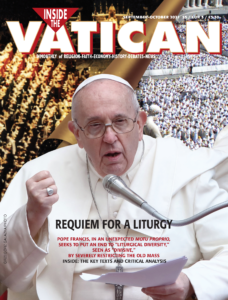
The cover of the September-October issue of Inside the Vatican with a dossier on the motu proprio Traditionis Custodes of July 16, 2021.
Kwasniewski: Certainly not. They always remain silent about unpleasant things, but I’m sure they’ve noticed it. At this point there is so much incoherence in the “application” of the motu proprio — the Pope has contradicted himself on multiple occasions since July 16, the Vicariate of Rome has gone beyond the motu proprio as well as departing from its provisions, the bishops in different countries and dioceses are issuing contrary prescriptions and proscriptions — that I imagine they are very busy just dealing with radioactive fallout.
From American Church officials?
Kwasniewski: Again, nothing. The recent meeting in Baltimore of the USCCB (in November) tells us that members of the “Universally Supine Conventicle of Craven Bureaucrats” are too busy making plans for the eventual closure of the churches in their dioceses to concern themselves with robust arguments on behalf of tradition or against its denigrators. With a few exceptions, they seem to be content consigning the most faithful and dynamic portion of their flocks to carefully controlled ghettoes or to the SSPX (Society of St. Pius X).
Am I the only one who finds it ironic that the US bishops, in view of still further evidence of the loss of faith in the Real Presence of Our Lord in the Eucharist, have been discussing how they might “better catechize the people on the Real Presence,” when meanwhile there’s a worldwide campaign against an ancient form of the Mass whose texts and ceremonies so profoundly express, eloquently emphasize, and effectively reinforce faith in that Real Presence?
How has the public received the book so far?
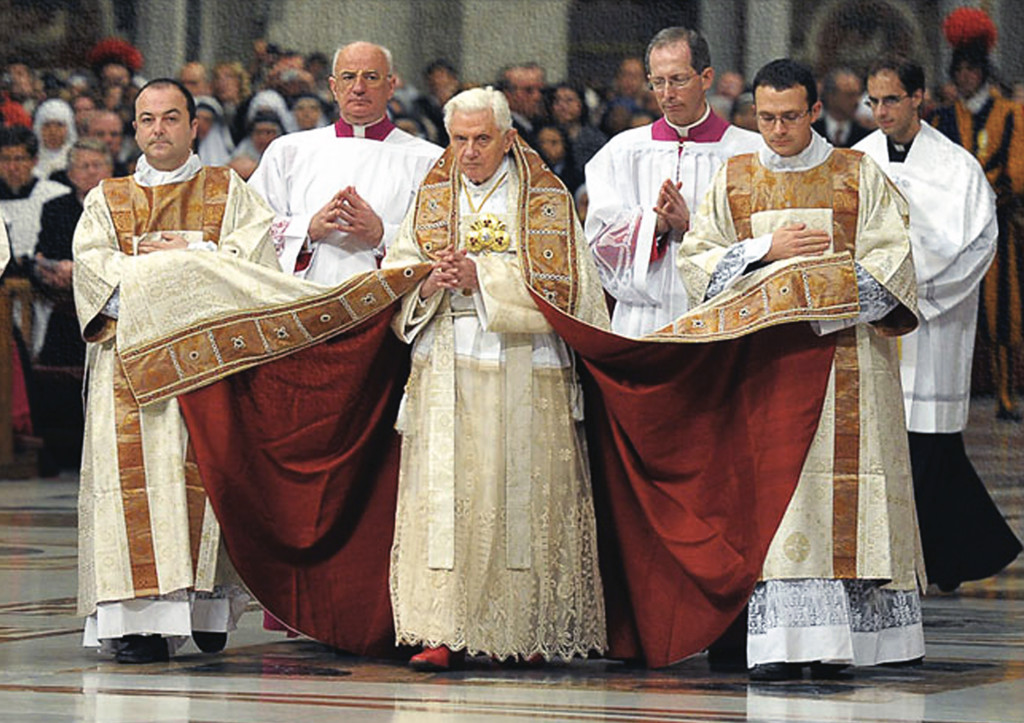
Pope Benedict XVI, who never hid his sympathy for the pre-Vatican II liturgical tradition of the Church
Kwasniewski: Extremely well. The laity and lower clergy are buying it, because it’s so comprehensive, galvanizing, and useful in the efforts we are making and must make to oppose this motu proprio and all that it stands for. As many of the articles show, TC isn’t just about “the Latin Mass.” It’s about an entire modern mentality, a system of rupture with the past, an attitude of negation toward the traditional Faith of the Church across the centuries. It enshrines a certain ideology that is, in fact, in its death throes, but still controls the levers of power. So yes, there’s obviously quite a bit of urgent interest in TC and, for that reason, the anthology meets a serious need.
Any unexpected reactions?
Kwasniewski: Two cardinals included in the book noisily distanced themselves from it, saying they were deceived, they never agreed, etc. I could publish evidence to the contrary. The fault lines are clear: there are those who wish to be considered “in” with the reigning party; and there is a tiny minority who will uphold the truth no matter what happens to them.
Do you think the TLM is in danger of being eradicated, or will that never happen?
Kwasniewski: Unquestionably the Latin Mass is here to stay. If the progressives couldn’t stamp it out in the 1970s, when there were far fewer traditionalists and the Church’s hierarchy, especially the Pope, could still expect and often receive prompt assent to decrees, however absurd, then there’s not even a remote chance of the now dinosaurian nostalgics and their ambitious hangers-on getting away with it in the 2020s.
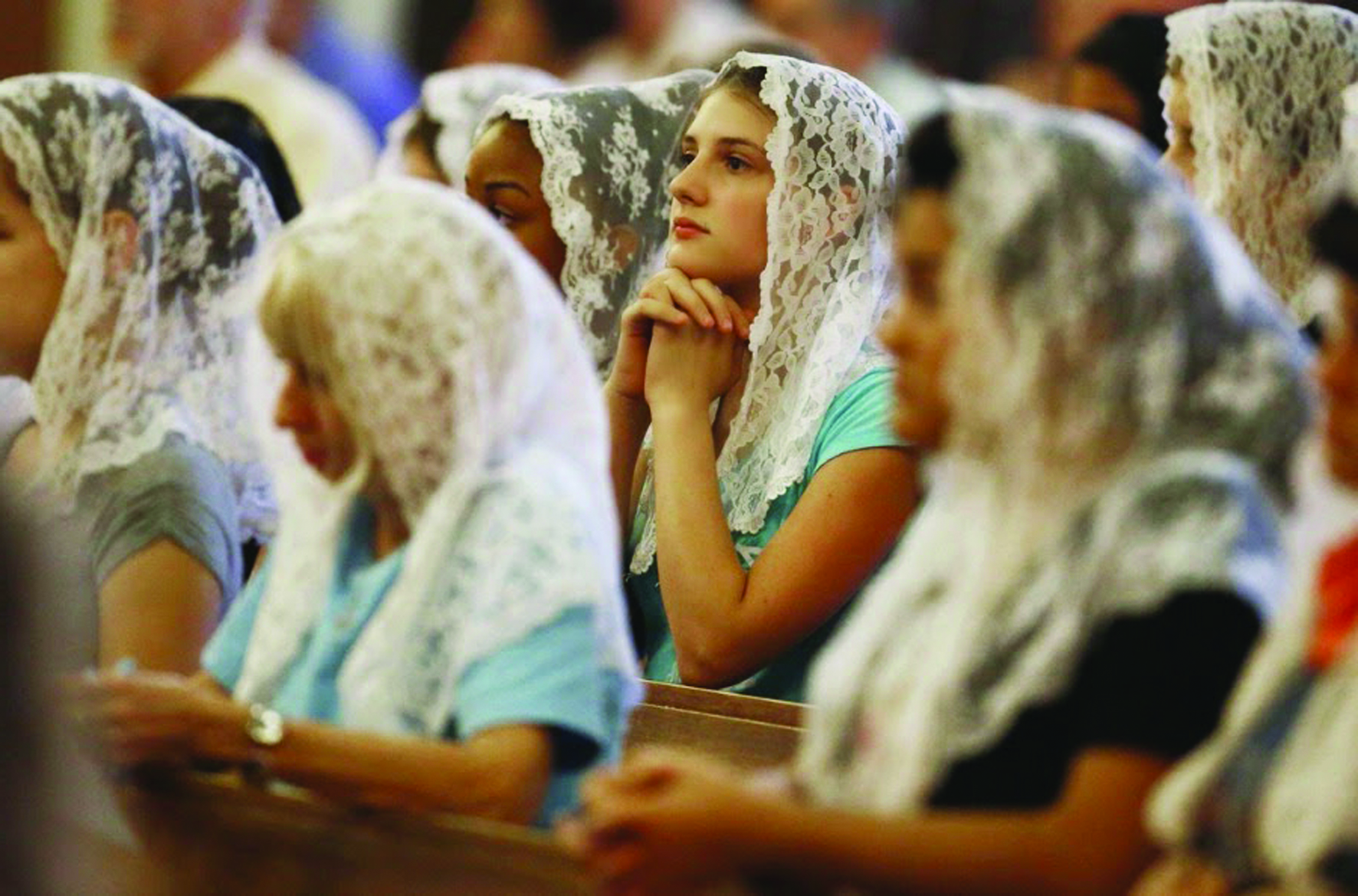
Will the traditional movement be stronger as a result?
Kwasniewski: In my 25+ years of writing on these subjects, I’ve never witnessed such an intense reaction and resolve as I see now. It’s not merely that attendance has been steadily climbing at TLMs since Covid hit, and again since July 16. It’s also that TC was like a sudden warning signal. So many priests and laymen have contacted me to say that they are learning how to say or serve or sing for the old Mass, adding it quietly to their parish or personal schedule, ramping it up, spreading it, doing it secretly — whatever it takes to outwit and outlast our enemies. No doubt about it: TC will backfire with historic thunder.
Many journalists talk about how small the traditional movement is. They say it is numerically insignificant. What’s your impression?
Kwasniewski: Interesting, isn’t it, that a “tiny movement” deserved such a heavy hammer? In reality, it’s not so small, and that’s why the hammer “had” to fall.
The movement for Catholic tradition embraces not only hundreds of thousands of laity and thousands of priests (I’m counting diocesan, Ecclesia Dei, and SSPX clergy), but also difficult-to-estimate numbers of conservative sympathizers and curious Christians on the margins. The internet has brought our oft-repeated concerns over liturgy, doctrine, and morals in front of huge audiences. For example, the first episode of The Mass of the Ages has been viewed on YouTube over a million times now. Statistics show that traditional Catholics are having much larger families and many more priestly and religious vocations (proportionally speaking). This alone shows the diabolic nature of TC, which attacks the primary locus of Catholic demographic growth in the Western world. “By their fruits you will know them.” This is true on both sides.
In this situation, do you have any reasons for hope?
Kwasniewski: Yes, for sure. Pope Francis has done us an immense service: he has exposed the absolute impossibility of reconciling Catholicism as it has always been believed, understood, and lived, with a certain kind of post-Vatican II “We Are the World” project. (How much of that project is already contained within the Council, and in what way, is a topic for another time.)
These days very little effort is invested in elaborate pretenses that everything is really fine, everything can be reconciled, everything is still Catholic. A certain openness has descended on us that comes as a freeing and healing balm. We can finally see what things are like in the light of day and call it as it is. Painful, no doubt, but absolutely necessary, like an addict having to admit his addiction before he can want help or look for it. The Church on earth has been sick for a long time, but the sickness has been hidden under artfully contrived cosmetics. The mask has fallen (one might anachronistically say), and we are staring reality in the face. This, to my mind, is immensely helpful, since we can better assess just what needs to be done — and start doing it (or keep doing it) energetically.


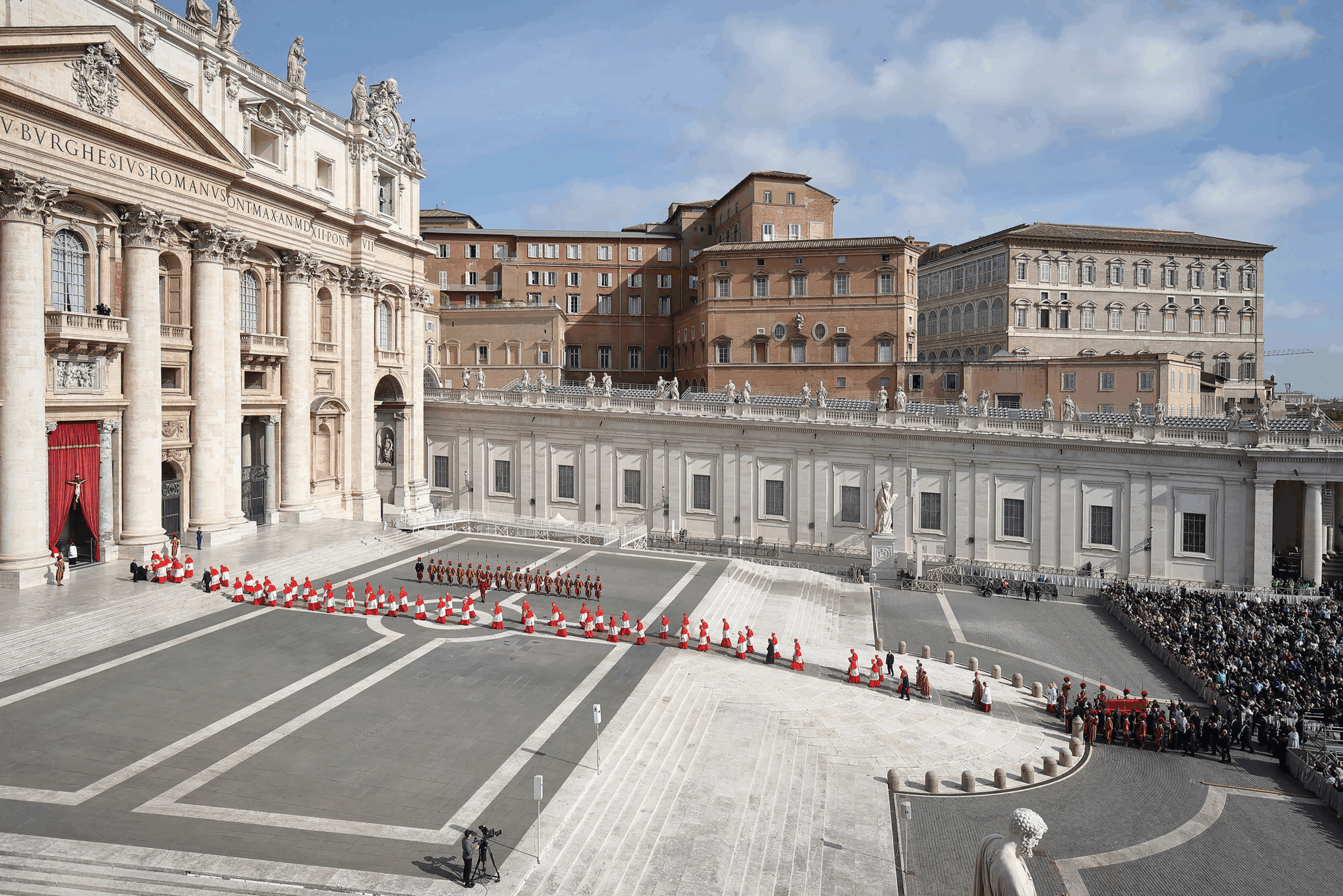




Facebook Comments